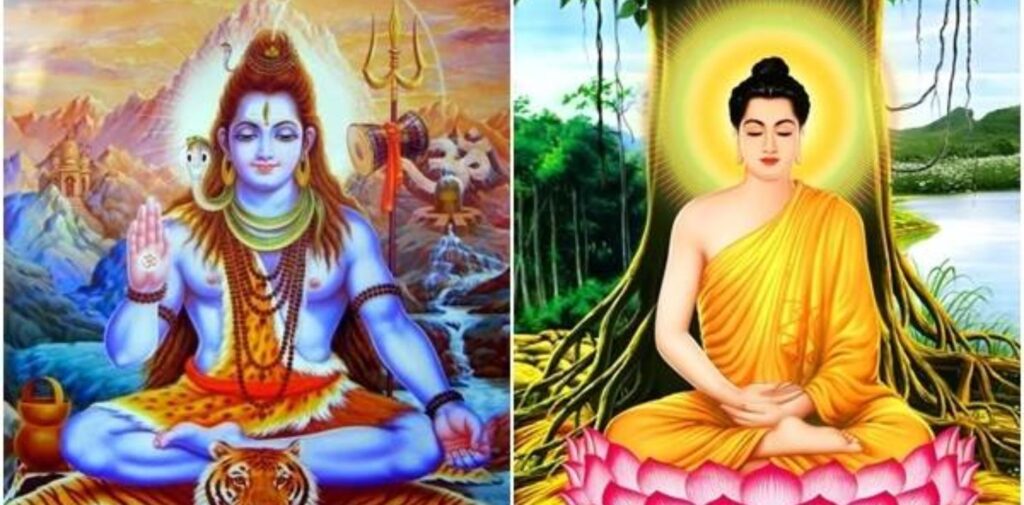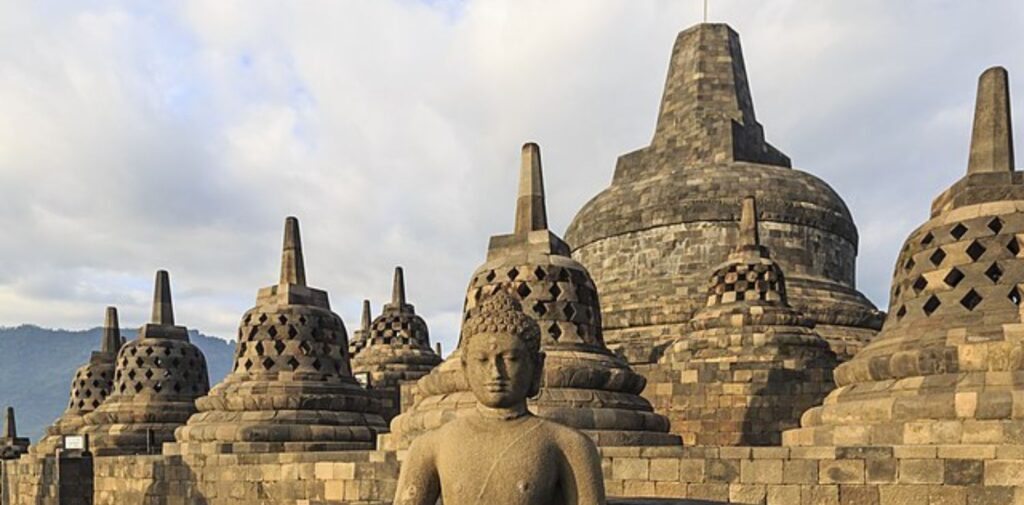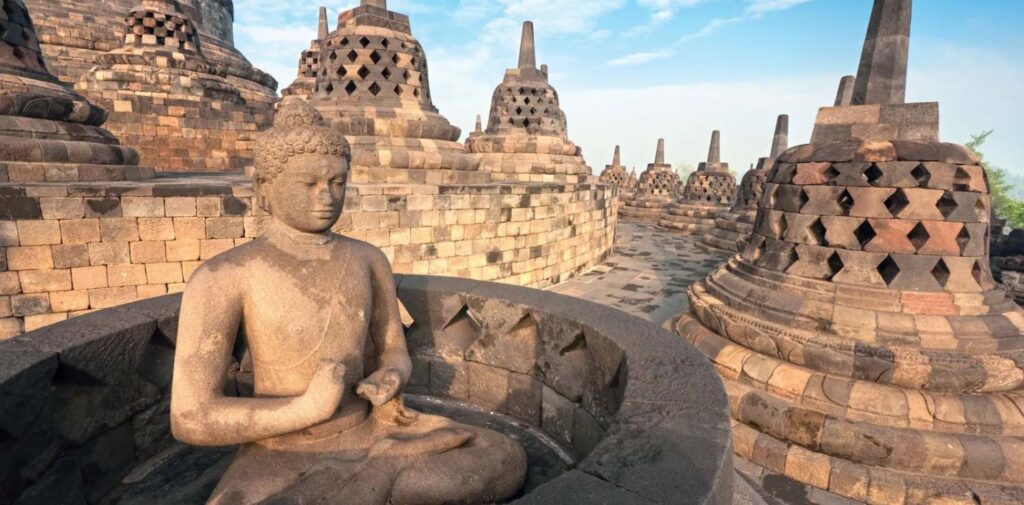A long time ago, India’s ideas, beliefs, and religions spread far beyond its borders and reached the distant lands of Southeast Asia. The Ancient Indian Religion, especially Hinduism and Buddhism, had a huge influence on the culture, art, and way of life in countries like Indonesia, Thailand, Cambodia, Vietnam, and Myanmar. These ideas didn’t just travel by trade but also through people, stories, and spiritual teachings.
In this article, we’ll explore how ancient Indian religion played a major role in shaping the societies and cultures of Southeast Asian kingdoms. You’ll learn how the spread of Hinduism and Buddhism influenced their rulers, their temples, their art, and even their way of thinking about life and the universe.
Ancient Indian Religions: Hinduism and Buddhism
Before we dive into how Indian religions influenced Southeast Asia, let’s first understand what these religions are about.
- Hinduism is one of the oldest religions in the world, which started in India. It teaches about dharma (duty), karma (the law of cause and effect), and moksha (freedom from the cycle of life and death). The religion believes in many gods and goddesses, and its most famous gods are Vishnu, Shiva, and Brahma.
- Buddhism was founded by Siddhartha Gautama, known as the Buddha, around 2,500 years ago. It teaches about overcoming suffering and finding peace by following the Four Noble Truths and the Eightfold Path. Buddhists believe in meditation, mindfulness, and the idea of nirvana, or freedom from suffering.
Both religions emphasize peace, spirituality, and understanding the world around us.

How Indian Religion Reached Southeast Asia
Thousands of years ago, people from India traveled to Southeast Asia for trade, spreading not only goods like spices and silk but also their religion, culture, and ideas. The Silk Road and Maritime Trade Routes connected India with Southeast Asia, and through these routes, both Hinduism and Buddhism began to spread.
The Indian merchants, priests, and scholars played an important role in spreading these religions. They introduced Indian myths, stories, and religious practices to the people of Southeast Asia. Rulers and kings of Southeast Asian kingdoms were interested in these new ideas, and they often accepted them, making Hinduism and Buddhism part of their royal life and culture.
Influence of Hinduism on Southeast Asia
Hinduism had a significant influence on the kingdoms of Southeast Asia, especially in Indonesia, Cambodia, Thailand, and Vietnam.
Hindu Rulers and Kingdoms
Many Southeast Asian kings were inspired by Indian rulers and followed Hinduism. The kings often considered themselves gods or divine rulers, just like the kings in ancient India. They believed that they were the incarnations of gods like Vishnu or Shiva.
For example, in Indonesia, the kingdom of Majapahit was heavily influenced by Hinduism. The rulers built huge temples dedicated to the Hindu gods, and Hindu rituals were part of their royal ceremonies. The Khmer Empire in Cambodia also had Hindu rulers who built the famous Angkor Wat, a temple dedicated to the Hindu god Vishnu. This grand temple shows how important Hinduism was to the people of the time.
Architecture and Temples
One of the most visible signs of Hindu influence in Southeast Asia is the grand temples that were built in ancient times. These temples were often dedicated to Hindu gods and were designed in the Indian style of architecture. For example, the Angkor Wat temple in Cambodia was originally built as a Hindu temple before later becoming a Buddhist site.
The Bali island in Indonesia is also a famous place where Hinduism continues to thrive. The temples in Bali, like Pura Besakih, show how Hindu architecture has influenced the island.
These temples were not just places of worship; they were also centers of learning and culture. People gathered in these temples to discuss religious ideas, celebrate festivals, and participate in rituals that connected them to the gods.
Indian Mythology and Stories
Indian myths and stories, especially those from the Ramayana and the Mahabharata, also spread to Southeast Asia. These epic tales, which tell the stories of Hindu gods like Rama, Krishna, and Shiva, became very popular in Southeast Asia.
For example, the Ramayana was adopted in Southeast Asia, and different versions of it were told through dance, theater, and art. In Thailand, the Ramakien is the Thai version of the Ramayana, and it is still performed in dance and drama today.

Influence of Buddhism on Southeast Asia
After Buddhism began to spread from India, it had a huge impact on the Southeast Asian kingdoms as well. Buddhism became especially popular in countries like Thailand, Myanmar, Cambodia, and Laos.
Buddhist Kings and Monks
Much like Hinduism, Buddhism attracted the attention of rulers in Southeast Asia. Many kings and emperors of these regions were patrons of Buddhism, supporting the building of temples and the work of Buddhist monks. In Thailand, for example, the royal family supported Buddhism, and it became the main religion of the country.
Buddhism also influenced the art and culture of Southeast Asia. Monks from India traveled to Southeast Asia to teach the principles of Buddhism. In return, Southeast Asians went to India to learn more about the religion, especially visiting places like Bodh Gaya, where Buddha is believed to have attained enlightenment.
Buddhist Temples and Architecture
Just like Hindu temples, Buddhist temples in Southeast Asia are amazing examples of how Indian influence shaped the region. The famous Shwedagon Pagoda in Myanmar is a beautiful Buddhist temple that shows the deep connection between Indian Buddhism and Southeast Asia.
In Thailand, Laos, and Cambodia, you can find many large stupas and pagodas. These temples are often designed with Indian influence, with their tall spires and intricate carvings.
Spread of Buddhist Teachings
Buddhism also influenced the way people in Southeast Asia thought about life, suffering, and peace. The teachings of the Buddha about kindness, meditation, and living a simple life became very important. Many Southeast Asian countries, including Sri Lanka and Thailand, still follow the teachings of the Buddha today.

Lasting Legacy: Hinduism and Buddhism in Southeast Asia Today
The influence of Indian religion on Southeast Asia is not just something from the past. Even today, Hinduism and Buddhism continue to play important roles in the daily lives of people in the region.
In Bali (Indonesia), Hinduism is still the main religion, and people celebrate traditional Hindu festivals like Galungan and Kuningan. Thailand remains a largely Buddhist country, where festivals like Songkran (Thai New Year) are celebrated with religious rituals.
The art, architecture, and stories of ancient Indian religion still live on in the temples, festivals, and culture of Southeast Asia. The influence of these ancient beliefs can still be seen in the way people live, worship, and celebrate life.
Conclusion
Ancient Indian religions, especially Hinduism and Buddhism, had a deep and lasting influence on the kingdoms of Southeast Asia. Through trade, kings, and religious travelers, the ideas, beliefs, and practices of India spread to the lands of Southeast Asia, shaping their societies, art, and spiritual lives.
Today, the influence of these ancient religions can still be seen in the temples, festivals, and everyday life of people in Southeast Asia. The legacy of India’s spiritual and cultural exchange with Southeast Asia is a reminder of how the world’s religions and ideas can travel across borders and shape the course of history.




